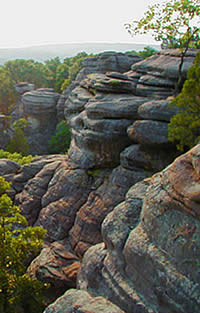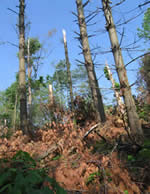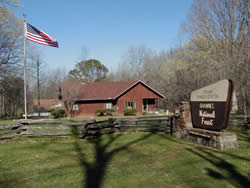Healthy Forests Success Story
Buttermilk Hill - Talbott Hollow Blowdown Project
Shawnee National Forest
Healthy Forests - Fuels Reduction
July 2009
Project Description

Bluffs on the Shawnee National Forest.

Tornado damage.
The Buttermilk Hill - Talbott Hollow Blowdown Project, located on the Mississippi Bluffs Ranger District of the Shawnee National Forest in Southern Illinois, was designed to reduce fuel loadings and the potential for high-intensity wildfire associated with widespread tornado blow-down and decades of fire exclusion. In the fall of 2006, a tornado damaged about 3,800 acres in Jackson County, Illinois, including 2,450 acres of Shawnee National Forest and 1,350 acres of adjacent private land.
The Buttermilk Hill-Talbott Hollow Blowdown Project will also begin restoration of a native oak-hickory forest community to maintain and improve native species diversity. The forest has changed in structure and composition due to the abovementioned tornado and a history of fire suppression.
The Buttermilk Hill-Talbott Project began as a typical NEPA analysis, but, in the spring of 2008, it was moved under the environmental analysis authority of the Healthy Forest Restoration Act of 2003 (HFRA). Currently, the project is in its implementation stage with plans to use prescribed fire on about 5,650 acres. Each area is scheduled to be burned three times over the next decade. This treatment will include tornado-damaged areas, as well as those areas designated for the restoration of a native-oak hickory forest community.
Collaboration Success
From its inception, the Buttermilk Hill-Talbott Hollow Blowdown project has been guided by a dedicated interdisciplinary team of resource specialists committed to working with the public. The Forest made considerable efforts to reach out to all interested parties to understand their views and work collaboratively. Collaborative partners included local emergency response organizations, management agencies, farmers, utility companies, the Illinois Department of Natural Resources, and about 46 private landowners. Collaborative efforts included:
- Door to door outreach was conducted and letters were sent before and during the project’s implementation.
- Public participation as required under the National Environmental Policy Act.
- Many site visits and regular communication with interested individuals.
- Public meetings and presentations in which plans were displayed and discussion encouraged.
- Several meetings were conducted with other government agencies, non-governmental agencies and other specialists and individuals interested in watershed management.
- The Conservancy District and Watershed Partnership were very active and supportive.
- The Forest Service encouraged and supported the local development of a potential Community Wildfire Protection Plan. Specific collaborative actions included:
- Meetings with private landowners to explain how low-intensity under-story burns work and negotiating where fire lines would be relative to property lines. The Forest was able to resolve a local landowner’s concerns by slightly moving the burn area boundary.
- The burns were coordinated with utility companies so that areas are burned in the season immediately following power line right-of-way maintenance. Utility companies also helped by clearing around infrastructure.
- Additional help was offered by many landowners to move wood and conducted pre-fuel treatments on project areas located on adjacent private lands.
Lessons Learned

Mississippi Bluffs Ranger District Office, Shawnee National Forest.
- Collaboration allowed the Forest Service to expand the impact of the project on a larger landscape level by including adjacent private lands within a broader project.
- The objection process allowed concerns to be addressed upfront, and less likely to end in court appeals. However, two objections were unresolved due to broader philosophical differences.
- In the absence of a unified group of community members or third party coordinated effort, the Forest Service took commendable actions to reach all interested parties and collaborative partners. Scott Crist, District Fire Management Officer believes that active community initiative and participation is needed to help lead the charge and create an even more successful collaborative process.
- Hazardous fuel reduction projects face particular challenges in the eastern regions of the United States. More land is in private ownership around eastern National Forests, making it difficult to treat larger landscapes. There is also a lack of perceived wildfire threat in the east because fires often occur less frequently and are less severe compared to in the western United States. This can make it difficult to gain the necessary support for such projects. However, it is important for collaborators to understand that increased fuel loadings and potential wildfire threats also occur in the eastern United States.
For More Information
Contact Shawnee National Forest
Scott Crist
Mississippi Bluffs Ranger District Fire Management Officer
(618) 687-1731
scrist@fs.fed.us